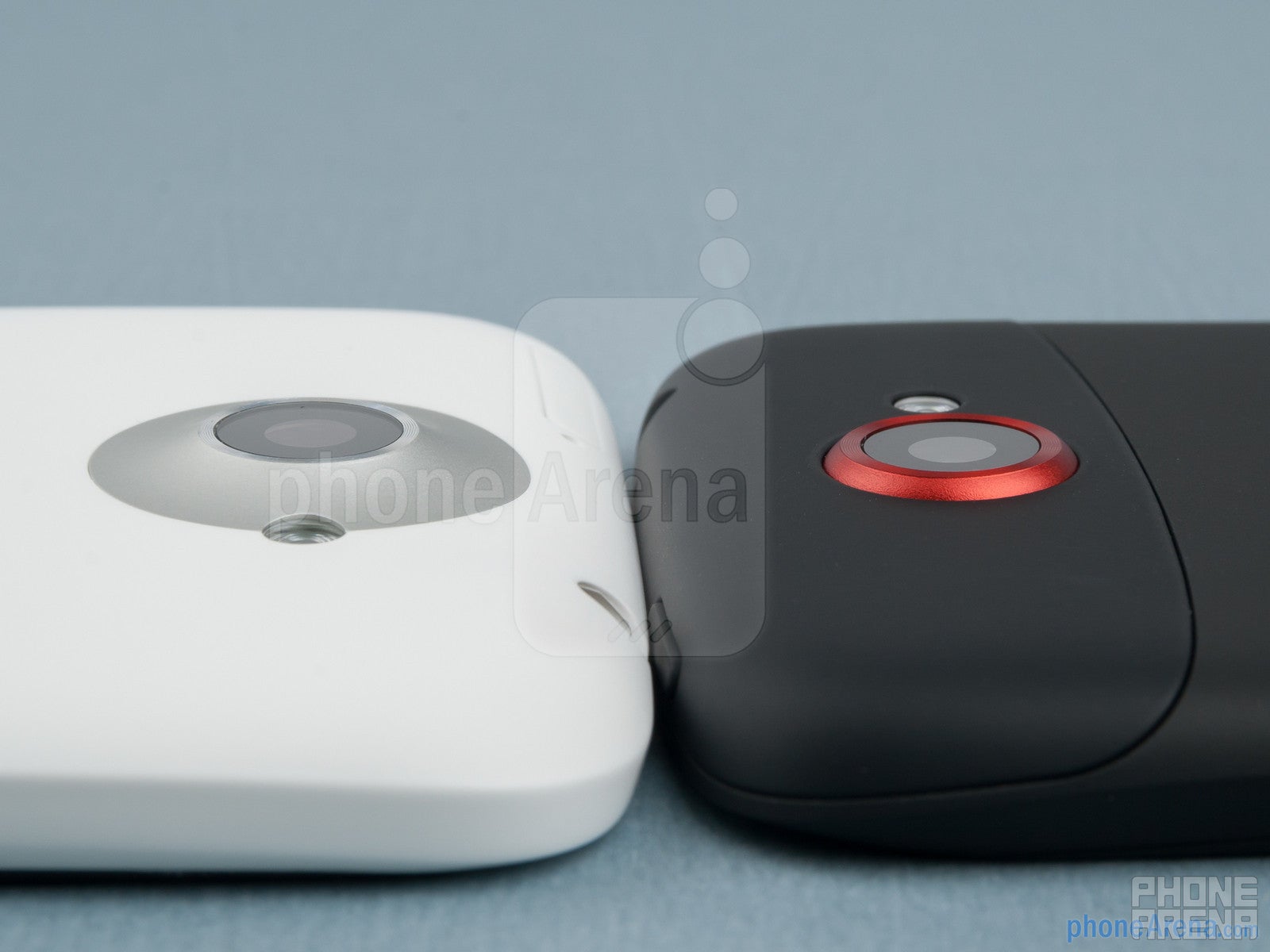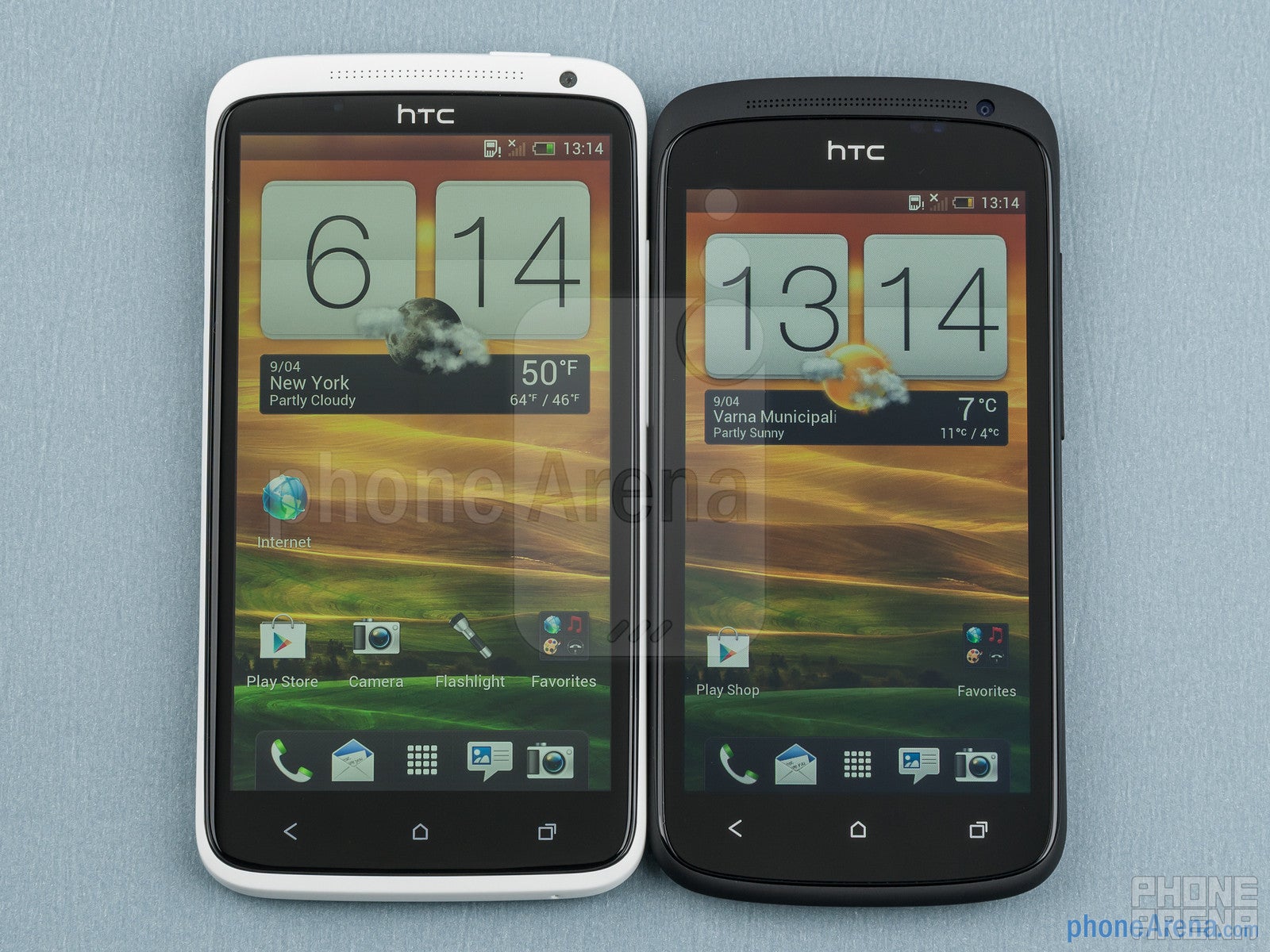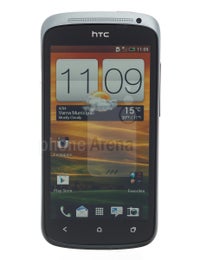HTC One X vs HTC One S

Introduction:
With its new One lineup of Android 4.0 handsets, HTC said it aims to achieve a more focused and distinct portfolio of handsets, rather than spreading efforts over many names with unconvincing differences in hardware and design – a strategy that proved wrong in 2011 with the Sensation line.
The One series includes the HTC One X, One S and One V – simple, easy to remember naming scheme, which will be marketed under the One brand, and in fact HTC launched its biggest PR campaign ever for it.
With the current comparison we want to help with the choice most HTC aficionados will face when looking at the One series – should I get the HTC One X flagship, or the upper mid-range One S? We leave the One V out, since its entry level status makes it an easy budget-friendly pick.
HTC has the newest Sense 4.0 interface on both the One X and the One S, so we'd mainly focus on the design and performance of those two. Which is the One for you? Read on our comparison to find out...
Design:
HTC is clearly experimenting with modern chassis materials with the One X and One S, and the polycarbonate unibody logically went to the larger One X, keeping its weight in check. We first saw this material introduced in the Nokia N9, then the Nokia Lumias, and now HTC is following suit. The advantage, besides flexibility, durability and light weight, is polycarb's deep coloration, so even if you scratch it, the body underneath is the same color.
Does polycarbonate achieve its goal in the One X? Well, let's just say that the 4.3” aluminum Sensation from last year weighs 5.22 oz (148 g), the 4.3” plastic Sony Xperia S from this year weighs 5.08 oz (144 g) , while the 4.7” HTC One X weighs just 4.59 oz (130 g).
The One X the lightest handset for a screen of this size, and also very thin at 0.35” (8.9mm), but can by no means be called compact. It's long and wide, and pretty hard to operate with one hand, as all big screen phones are. It lies pretty well in the palm, though, thanks to its slightly curved chassis.
The One S, on the other hand, is one of the most compact 4.3-inchers we've ever handled, and certainly usable with one hand due to is narrower elongated profile, allowing your thumb to reach almost everywhere on the screen. It is HTC's thinnest smartphone to date, and despite its metal chassis weighs as much as the Galaxy S II, which is all-plastic and the same screen size.
Moreover, the blue anodized aluminum gradient, or the black ceramic metal coating versions of the One S certainly send a more premium feel to your senses than when holding the HTC One X white or black polycarbonate body. Both phones exude a premium build quality, though, with no creaks or crevices, and have easy to feel and press side buttons.
Both fronts sport a waterfall design, where the bezel of the display seemingly falls off uninterrupted to the sides, but it is an optical illusion, and the phones actually have the usual wide bezels and slightly recessed screens.

HTC's new premium phones also only take micro-SIM cards, with the One X providing a pin in the box to help you withdraw the tray on its back, and the One S micro-SIM slot having a latching mechanism for the card under a removable plastic section on its upper back.
Displays:

It is also with normal RGB matrix arrangement, unlike the PenTile AMOLED display on the One S, which makes certain elements look pixelated. The smaller 4.3” display also sports lower 540x960 pixels resolution, but it still results in 256ppi pixel density. This is smaller than the 720p screen on the One X, but still above average and enough for everything thrown at it, including reading smaller text.
The AMOLED display has much wider than the standard color gamut, resulting in way oversaturated colors, which seems a bit off in the interface, but thoroughly enjoyable when watching movies, for example. Don't get us wrong – the screen on the HTC One X also sports a very good contrast ratio for an LCD and accurate gamut, but it's hard to beat the true blacks and jolly colors of the AMOLED displays.
The AMOLED screen on the One S, however, is plagued by the same cold colors that most OLED displays of Samsung's make exhibit, with white rapidly deteriorating into a very blueish tint here when the screen is tilted further from 30 degrees or so. It compensates with high brightness and very good outdoor visibility, which is almost on par with the One X.
HTC One X 360-degrees view:
HTC One S 360-degrees view:
Interface:
We've made an extensive hands-on and video review of Sense 4.0, the new interface of HTC made for Android ICS, and that's what both the One X and One S come with, so you can check out the new looks and functions there.
Both the quad-core Tegra 3 and the Snapdragon S4 processors plough through the interface with ease, as can be expected from the best silicon currently on the market. Still, with Tegra 3's implementation in the One X we did experience some annoying hiccups, like the phone taking a few seconds to load back the interface when we pressed the home button to exit the browser, with the loading circle appearing for a while.
With the One S, on the other hand, we couldn't use the new ICS screenshot-taking ability in landscape format, as the phone always froze and went into dump mode, so we had to reboot it with the volume rocker and power key – you can't just take out the battery on those, you know. So both phones have some teething problems with the new interface, which we easily expect from the first ICS efforts of most manufacturers. Launch and then update to iron out the kinks always seems to be the mantra. In fairness, the phone recognized when the abnormal reboot happened, and asked us to send the log to HTC for improvement.
Despite the interface changes made by Google with Android Ice Cream Sandwich that allow buttonless fronts, both phones sport three capacitive keys underneath their displays. This makes for the somewhat redundant two layers of navigational buttons in 3rd party apps – the capacitive buttons on one hand, and a virtual context menu key stacked on top of them in the on-screen navigational strip of Android ICS. In default apps, the virtual menu key is up right, easily accessible with just a slight thumb move.
Processors:
Tegra 3 is in a bit of unfair competition here, as it has to power a large 720p display, but we'll pit the best mobile processors currently on the market against each other anyway.
The HTC One X will stay in history forever as the first smartphone with a quad-core CPU, not that there are numerous applications that can use all four cores, but it's nice to shout “first”. In the other corner stays the HTC One S, which is the first with the dual-core Qualcomm Snapdragon S4 chipset, that is made with the 28nm process, ensuring a huge performance boost, yet a gentle run on the battery.
We won't say it's because Tegra 3 is still on the 40nm process, but it actually generates quite a bit of heat, which is felt when the HTC One X is under benchmarking or gameplay pressure, whereas the HTC One S keeps its cool regardless.
We got 5136 on Quadrant at first run from the One S, which is a pretty high result, 7015 on AnTuTu, and 204.9 MFLOPS on the Linpack multi-thread test, also quite a good score for the CPU. The Adreno 225 GPU turned out capable too, maxing out NenaMark 2 at the phone’s 60.3 fps cap. The graphics scored 49.13fps on the taxing Basemark ES 2.0 Taiji 3D benchmark.
The One X clocked in 4919 on Quadrant, 9749 on AnTuTu and 135 MFLOPS on the Linpack multi-thread test. The 12-core mobile GPU eked out 47.6fps on NenaMark 2 and 13fps on Taiji, but Taiji is known for working better with Adreno GPUs, and, hey, the Tegra 3 GPU has to power a giant high-res display, which sure counts for something.
Yet, we'd give the silicon round to the 28nm S4 on the HTC One S, be it only because you can hardly touch the metal camera rim when benchmarks are running on the One X, that's how warm Tegra 3 gets inside.
Messaging, Internet and Connectivity:
Despite the smaller screen, we actually give the typing preference to the One S, since we could easily shoot quick text message replies with one hand and our thumb, while it's quite a stretch (literally) to do that on the wide HTC One X.
The Sense 4.0 default browser works well overall on both handsets in terms of scrolling, panning and zooming, but has a choppy and inconsistent text reflow, which is on by default. HTC is trying to introduce an intuitive way to remove both the top and bottom navigational strips when checking out a website, leaving you with just its full screen glory. The idea is that each time when you start scrolling up, the address bar and the bottom strip would appear, sensing you are trying to navigate away from your current section, but when you lift your finger off they hide, leaving you in full screen mode, so you don't have to go through the settings to gain screen estate.
The result is hit or miss, though, with the strips sometimes appearing to get in the way of a good scroll, and sometimes not even showing up, regardless of the inertia you set, and these inconsistencies are more pronounced on the One X for some reason. Some people found the bottom navigational strip meddling with their browsing experience, some found it handy for quick saving of pages for later read or access to bookmarks and open tabs, so it might take getting used to.
The HTC One S has one less connectivity option compared to the One X, and it is NFC, which for now is not a big thing to miss. Both handsets sport the full suite otherwise, including Wi-Fi, GPS, Bluetooth 4.0, MHL and DLNA.
Camera:
The HTC One X and One S both have an 8MP camera module with LED flash and proprietary HTC ImageChip DSP that powers it on their backs. The result is one of the fastest operations out there, with sub-second times to focus and take shots.
HTC's marketing also touts the f/2.0 aperture and backside illumination of the sensor, as well as the ability to take pictures while filming, and take up to 99 shots in rapid burst mode, then just pick the best and kill the rest. The camera interface is also laden with options like panorama, HDR, face and smile detection, group portrait and macro modes. A rich set of Instagram-style effects is easily accessible by tapping on a blue orb in the interface.
The resulting pictures and video are a mixed bag, though. One would think that since we have the HTC ImageChip camera module on both we have to get the same results, but it isn't so. The HTC One S takes slightly oversaturated photos with good contrast and amount of detail. The colors are colder in the case of the One X, and it has more accurate color representation with white balance a bit off in some shots.
Indoors both handsets had their video framerates drop to 22-23, but it doesn't affect fluidity that much. Pictures and video indoors from both handsets are very good, with a fair amount of noise only when the light was at its lowest. The LED flashes have intelligent distance metering, lowering the intensity of the flash when an object is too near, so it doesn't get overexposed, and in most shots this technology performs well.
When it comes to video, the One S camera films sharp images with oversaturated colors and good level of contrast and detail at 30fps. The 1080p video from the One X performs even better in terms of color accuracy, but video capture starts slower than with the One S, and the camera struggles to focus and skips frames too often, especially in the beginning, recording with the slightly less fluid 28fps outside.
Multimedia:
Both phones feature the richer bass sound coming with their Beats Audio branding, but the results will, of course, vary, depending on the quality of the headsets plugged in – the handsets don't come with Beats unit in the box, but regular ones. The loudspeaker on the HTC One X sounds a tad better and stronger than the flatlining speaker on the HTC One S.
The video players work with everything thrown at them, including DivX/Xvid files out of the box, and up to 1080p definitions, so we could hardly ask for anything else on that front.
Performance:
Call quality on both handsets isn't going to give you any trouble, with loud and clean voices in the earpiece, and well-filtered background noise when you are talking, thanks to the noise-canceling mics. As mentioned, the loudspeaker is more powerful on the One X, so you are less likely to miss a call with it than with the One S.

The display technologies also play a role here – if you are watching movies, you'll get about eight hours mileage from the One S with its AMOLED display and the usual six from the One X. If intensive browsing is involved, though, expect it to tire much faster than the One X, which doesn't consume more energy when displaying white backgrounds as the One S does. In everyday scenarios the mixed usage about evens out the battery stamina of both handsets.
Conclusion:
In line with the intent to simplify its phone portfolio, HTC has made the One series trio pretty distinct from each other, and the final verdict in our One X vs One S comparison is very easy.
If you are a sucker for large and brilliant HD screens, you won't be bothered by the HTC One X's dimensions or the about 100 bucks (or euros) price premium, and grab it without second thoughts. It's light and comes with 32GB of memory to soothe your non-expandable storage pains.
If you are any other type of smartphone shopper, though, and that's the vast majority of people, we'd recommend you stick with the HTC One S – it is stunningly compact for a 4.3-incher, making one-handed operation easier, and also has a premium feel in the hand thanks to its thin ceramic metal or anodized aluminum chassis. You'll have to make do with 16GB of internal memory, but if you are eying any of those two, you are likely not bothered by their lack of memory card slots and non-removable batteries anyway.
HTC One X vs HTC One S:
Follow us on Google News
















Things that are NOT allowed:
To help keep our community safe and free from spam, we apply temporary limits to newly created accounts: